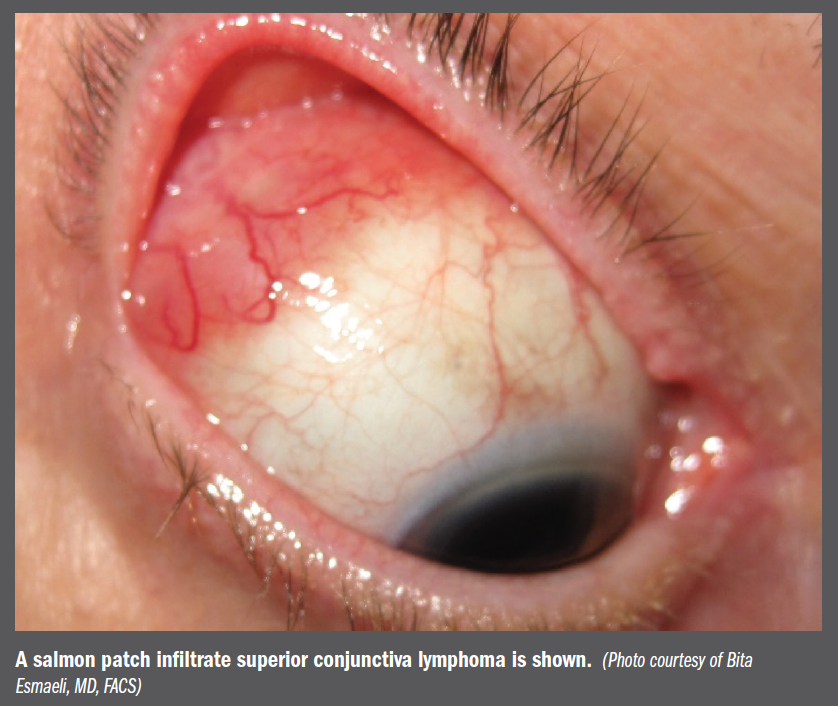Publication
Article
Digital Edition
Casting a net to diagnose, treat cancerous lesions
Author(s):

This article was reviewed by Bita Esmaeli, MD, FACS
Clinical recognition of salmon patch infiltrate requires the consideration of a number of factors, and it is the first important step in diagnosing and managing conjunctival lymphoproliferative lesions including marginal zone B-cell lymphoma.
Ophthalmologists should be familiar with the clinical appearance which is usually that of a “salmon patch” infiltrate and can affect any part of the ocular surface including the tarsal and palpebral conjunctiva.
This pathology is not limited to one area; the entire ocular surface must be inspected, according to Bita Esmaeli, MD, FACS, professor and director of the Ophthalmic Plastic and Orbit Program, at MD Anderson Cancer Center, Houston.
Eversion of the upper eyelid is important for identifying the full extent of conjunctival lymphomas. Some lesions, she explained, can be very small and limited to the caruncle or a small follicular infiltrate.
Symptoms can include chronic discharge, itchiness, conjunctivitis, and allergic reaction. In some cases, the lesions can be asymptomatic and discovered only coincidentally during the evaluation of other clinical processes.
Biopsy is key
Reactive lymphoid hyperplasia can have an appearance that is similar to lymphoma, indicating that biopsy is a key diagnostic step in ferreting out benign and malignant lesions, Dr. Esmaeli pointed out.
“Biopsy is required to establish the diagnosis of lymphoma and the exact histologic subtype,” she said.
Pathologists often rely on standard morphology, immunohistochemistry, and hematoxylin and eosin staining in cases with conjunctival lesions because the tumor burden may be too small to facilitate flow cytometry, the gold standard for more definitive diagnosis of lymphoma, she pointed out.
Surgeons should also bear in mind that evidence of a lesion on the conjunctiva may be the proverbial tip of the iceberg, that is, the disease can extend well into the orbit.
“For conjunctival lymphoma, the histology is usually very low grade, and more than 90% are likely mucosa-associated lymphoid tissue (MALT) lymphomas,” Dr. Esmaeli said. “Other more aggressive histologic subtypes of lymphoma also can rarely occur, and in most cases they would have an extension into the orbit.”
After diagnosis
At this stage, an important goal is ruling out systemic lymphoma. Positron emission tomography-computed tomography are useful, as are bone marrow biopsy, which are performed at most cancer centers-and even “stage 4” conjunctival MALT lymphoma is possible to be found at initial diagnosis of conjunctival MALT lymphoma with a positive bone marrow involvement.
“That does not necessarily mean that patients need aggressive treatment, but it could be a clue that such patients with a positive bone marrow biopsy will relapse in the future at extraocular sites,” she said.
Treatment
In cases of ocular surface lymphoma, probably more than 95% of patients undergo radiation therapy because the disease is characteristically low volume and low grade and in most cases does not extend past the ocular surface and is without systemic involvement.
“Radiation has served as the go-to treatment and the most practical solution for ocular surface lymphomas,” Dr. Esmaeli noted.
For the previous several decades, the current standard radiation dose for low-grade ocular adnexal lymphoma is 24 to 30 Gy delivered over two to three weeks, which is considered “low-dose” therapy. Dr. Esmaeli noted that this dose provides excellent local control in from 90% to 100% of cases. The late ocular morbidities include cataract development, mild keratitis, and dry eye in about 50% of cases.
More recently, an “ultra-low” dose of 4 Gy of orbital fractionated radiation that is administered in two sessions over two days has gained popularity and is currently being studied in a prospective trial at MD Anderson Cancer Center.
Dr. Esmaeli reported that a retrospective analysis of the results in 23 eyes of 20 patients treated with the ultra-low-dose radiation resulted in responses in all patients, including complete responses in 13 patients (56%) and partial responses in 10 patients (44%) after a median follow-up of 14 months.
These early observations were published in 2016. Based on the positive early observations, a prospective trial of the ultra-low dose radiation for orbital and adnexal low-grade lymphomas is underway at MD Anderson with the goal of recruiting 50 patients.
To date, 41 patients have been treated according to the protocol. When combined with the retrospective and off-protocol patients, a total of 70 patients have been treated. Advantages are short-treatment duration, lower cost, and lower ocular toxicity. The treatment also can be repeated if needed.
“We are very pleased with the results and this study may lead to a change in the acceptable dose of radiation delivered for low-grade lymphomas of the orbit and ocular surface,” Dr. Esmaeli pointed out, adding that the case of a patient treated in 2013 who responded well to the ultra-low treatment dose and had a prolonged treatment effect with follow-up in 2017.
Other forms of treatment for lymphoma include chemotherapy, combined chemotherapy and radiation, immunotherapy, observation, and oral antibiotics, the last of which have no proven efficacy. These other treatment options may be needed in advanced stages or high-grade lymphoma.
“Clinical recognition of salmon patch infiltrate is the most important first step,” Dr. Esmaeli concluded. “The next step is biopsy to establish the histologic subtype of the lymphoma, which dictates treatment. Staging is vital. For stage 1E disease, very-low dose radiation, even 4 Gy, provides effective local control, convenience, and has low ocular toxicity.”
Bita Esmaeli, MD, FACSE: besmaeli@mdanderson.org
Dr. Esmaeli has no financial interests in any aspect of this report.
Newsletter
Don’t miss out—get Ophthalmology Times updates on the latest clinical advancements and expert interviews, straight to your inbox.






